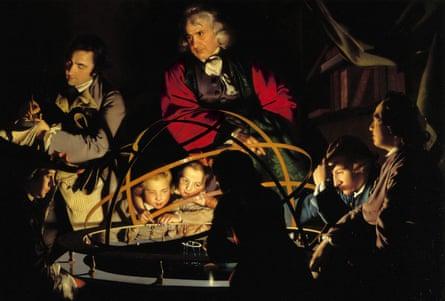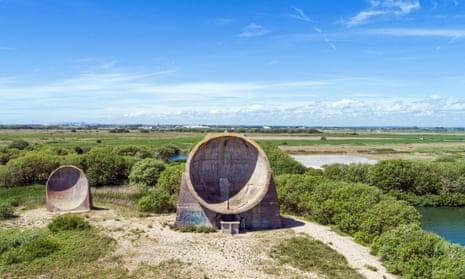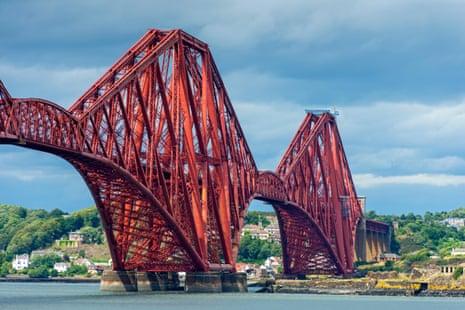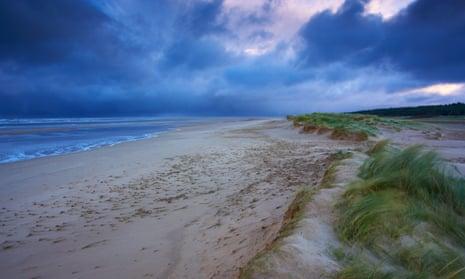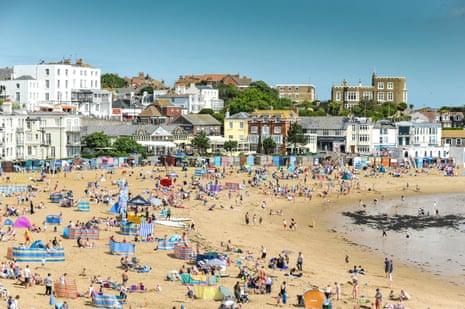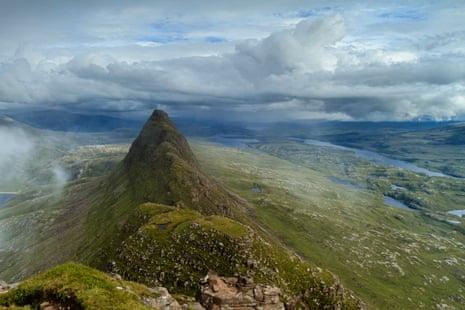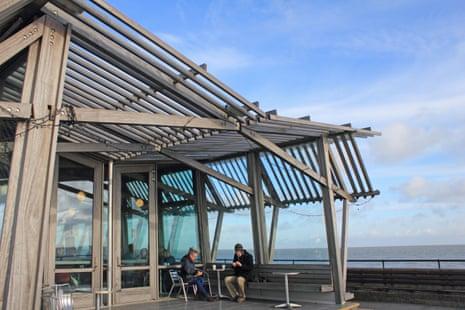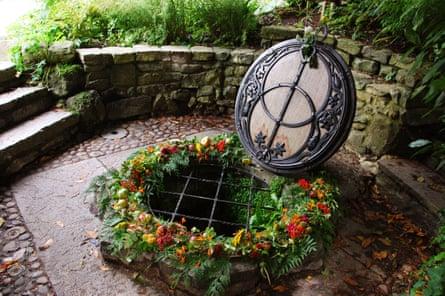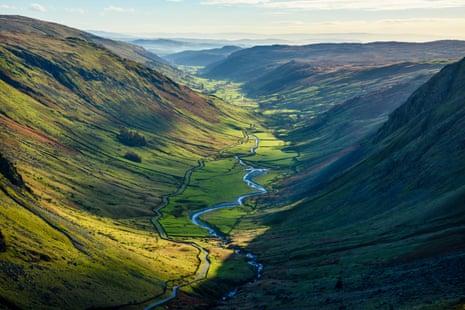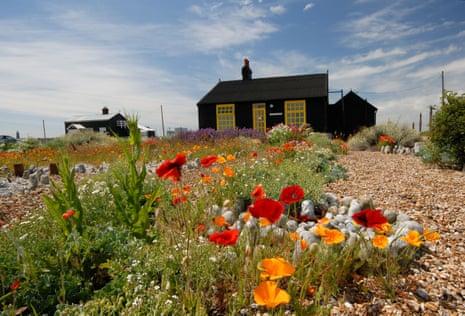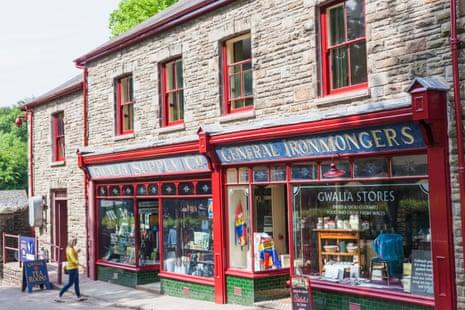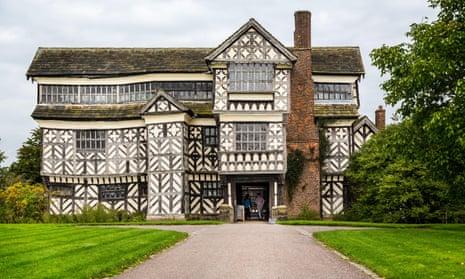Isle of Arran
A short sail across the Firth of Clyde on a red-funnelled Caledonian MacBrayne ferry takes me to the wonderful sight of the Isle of Arran, cutting through the water, with Goatfell to the right and Holy Isle just in view off the picturesque village of Lamlash. These are the coordinates of joy, no matter the weather. It’s a place of family holidays, parties, friendship and, for me, creativity. I love to travel the wonderful “String” road – climbing high out of Brodick, over the moors and down into the fertile valley and the beach at Blackwaterfoot, blasting music into the blue cloud-blown sky – eat at the Drift Inn in Lamlash, and walk through the historic gardens at Brodick Castle. I first stayed on the island when I was not two years old and, according to my parents, in the bedroom of the B&B I ripped the wallpaper off the wall beside my cot, much to the landlady’s fury. That was before we had a car, and I was carted around the island on a bike. I go to Arran whenever I can. It was the setting for my first novel, The Legacy of Elizabeth Pringle and on 1 September I’ll be at the Clamjamfry – the arts and music festival named for the Scottish word for a rabble. I’ll speak about eight pieces of art that have inspired me, and I’ll choose them all from the island, chief among them Craigie Aitchison’s luminous and intense paintings of Holy Isle, a place he loved.
Kirsty Wark, Newsnight presenter and Landmark Trust ambassador. Her new novel, The House by the Loch (Two Roads, £16.99), is out on 13 June
A Starry Celebration: Underneath the Stars Festival, Barnsley
Lower the ale mug, particularly that one teeming with woodsy, chocolate hints. Behold, another duo sporting dungarees with rainbow-hued tank tops, eclipsing the festivity with their vibrance. Truly, the Underneath the Stars festival held from 2nd - 4th August 2019, eclipses everything with its sheer beauty. Blanketed within a lush forestation nestled amidst the undulating vistas of Cawthorne, close to Barnsley, it represents a serene sanctuary. An exemplar of English politeness with its guests respecting one and all, the gathering is devoid of pretentiousness and vanity. For safeguards, you have the pleasure of a charming Woman's Institute member serenely assisting you in securing your entry bracelet. Thus, as you recline on your deck chair, cradling your pint, you feel sheltered and comfortable, a respite from the world's tumult and self-reflection. The festival is not marred by foreboding tunes such as My Dying Bride or Goblin Cock, but rather, filled with joyful folk musicians singing melodies of serene revolution. One could say the festival itself is a revolution, shifting away from the hustle and bustle and bringing forth an air of calm.
Durham
Overlooking from the historic Framwellgate Bridge presents a breath-taking panorama of Durham, one of England's most beautiful architectural and natural landscapes. Famed architecture historian Nikolaus Pevsner classed its exquisite vista on par only with iconic international destinations such as Prague and Avignon. High up on the promontory, the imposing castle and cathedral paint the skyline, a robust testament to Norman might following their successful campaign against a hard-fought northern opposition.
The uphill journey along the medieval lane towards the fortress only solidifies its grandeur, giving modern travellers a glimpse into the majiv of the middle ages. Interestingly, the space inside the castle still resonates with its monastic past, juxtaposed with the lively energy brought by students studying under detailed and beautiful dogtooth archways.
The cathedral is a sight to behold. Its splendid, well-preserved edifice is gently offset by the vibrant colours of the surrounding gorge, creating a harmonious blend of nature and human craftsmanship. Sandstone fortifications resting proudly atop the hills resemble a resting giant, silently guarding the city. The tower, standing omnipotent above the contemporary rooftops, reminisces its past dominance over simpler mud and thatch dwellings.
An intricately designed ornamentation adds a whimsical touch to the austere west towers. Inside, a rhythm of famous Durham arcades beats the reminder of the endless Norman legacy. With all this overwhelming spectacle, it comes as no surprise that the Saxon opposition had no choice but to acquiesce. Durham's historic preservation and beauty certainly earn it a place among the UK's top 50 favourite places.
Exploring the Antiques of Newcastle's Grainger Market
Throughout the composition of my latest book, I found myself frequently drawn from the confinement of my Newcastle workspace to the enchanting labyrinth of passages within Grainger Market. Tucked within an urban block, it discreetly occupies the rear of street-front shops. The vaulted interiors of the Victorian market are a product of the 19th century, taking me on an enchanting journey back to that era. Embracing the warm glow that filters through the row of clerestory windows above stirs the nostalgic spirit within me. The recollection of my past unwinds in this setting, like a ravelled spool of thread, leaden with memories of my Irish homeland. Although I've made the North East my home for close to six years, reminders of my past come to play here, before being overshadowed by the pivotal currents of Britain's unfolding political scenario. Within the market's embrace, a vibrant spectrum of vendors from different parts of the globe meet — English butchers share space with French crêpe artisans, and Chinese dumpling specialists vie with Turkish street food and Italian pizzaiolos. Being at Grainger Market, it becomes an interesting ground to mull over the world as it stands and envision its future iterations.
Denge, Kent
Rising out of the endless shingle landscape like curious monuments from a future civilisation, the “listening ears” at Denge, on the Kent coast near Dungeness, are one of the strangest sights in the country. They poke up above the horizon like gigantic fossilised satellite dishes, isolated on an unreachable island across a moat, making them all the more enticing. These great bowls of concrete were built as an early warning system to detect enemy planes approaching Britain across the Channel. Constructed between 1928 and 1935, they were defunct almost as soon as they were finished. Faster aircraft and the invention of radar before the start of the second world war made them redundant, leaving them as anachronistic relics – and a poetic place of pilgrimage for lovers of concrete ever since.
Green Dragon Inn, Hawes, North Yorkshire
The Green Dragon Inn in Hawes, North Yorkshire, is a place that should only exist in the imagination. From the outside, it looks like any old ancient English inn – a lovely place to stop while rambling in the Yorkshire Dales. But the back door is the only access point to a secret and beautiful walk, through fauna and flora ending at a spectacular waterfall that forms the basis of many sweet memories from my childhood.
Wimbledon
The only event that can rival Wimbledon in my affections is Notting Hill Carnival, but I’m going with the former because although they’re both great festivals, there’s no tennis at Carnival. Granted, the costumes are not as much fun and, at the risk of seeming chippy, I cling to the belief that it is impossible to wear a panama hat without looking like a tosser. The Royal Box and debentured seats – aka inherited touting – are stains on England’s green and otherwise pleasant Centre Court, but everything else about Wimbledon – the way the players’ names are not announced as they make their way discreetly on to the courts, the lack of music during end-changes, the all-white rule for competitors’ clothing, the lack of advertising, the emerald glow of the grass, the pervasive conviviality of the crowds – is a source of joy and pride.
Author Geoff Dyer, whose latest book is Broadsword Calling Danny Boy (Penguin £7.99)
Royal Cornwall Museum, Truro
I have lived in Cornwall for nigh on 30 years now, and the place for me that distils all its cliff-edge energy and un-English history is the mineral collection at the Royal Cornwall Museum in Truro. Cornwall is a hotspot of geological diversity: an amazing 14% of the earth’s 400-odd minerals can be found beneath its soil. From the bronze age right up to the industrial revolution, the miners of Cornwall have played their part in shaping the world. But there is nothing functional about the collection of rocks on display in Truro. They are miraculous displays of the earth’s elements, of what happens to copper and tin and iron when they are subjected to intense heat and pressure – the greens of malachite, the yellows of bassetite, the intense blues of azurite and liroconite, the fantasy landscapes of crystals. It is a place to lose yourself in wonder.
Philip Marsden, whose new book, The Summer Isles: A Sea Voyage (Granta, price tbc), is out in October
The Forth Bridge
In my palm, a talisman: a brittle dome the colour of dried blood. It’s paint, flaked off the Forth Bridge, formed around a rivet – one of 6.5 million – during unending repaintings. This ghost rivet, which I found one day while on the bridge for work, brings to mind the entire structure – 2,467 metres of it stretching from Lothian to Fife. The bridge has stood in the firth since 1890, and stands for how we in Scotland like to see ourselves: strong, ingenious, a pragmatic grace weatherproofing us against life’s winds and tides. It – she – is beautiful. Look at her psychedelic geometry. Look at her unyielding span. Put her on a tea towel and she loses no dignity, transcends kitsch. I love her beckoning steel.
Peter Ross, author of The Passion Of Harry Bingo (Sandstone Press, £8.99)
Northallerton Station Hotel, North Yorkshire
It may look like any old Victorian pub, serving big fried breakfasts and Sunday lunch, but the Station, with its roasting log fire and quirky teapot collection, embodies a particular warmth. A few pounds buys a giant pot of Yorkshire tea and a plate of cake: perfectly gooey homemade brownies or ginger parkin from Whitby. The Cleveland Way, a beautiful, looping, long-distance route across the North York Moors, is a 20-minute bus ride from Northallerton. The path was knee deep in snow early last year, with black grouse chirring out of the white-muffled heather. Our spectacular hike ended back at the Station, with our soaked socks steaming warmly by the fire as we waited for the train.
Holkham beach, Norfolk
There is something very British about a beach that is at its most beautiful in bad weather. Idyllic under blue summer skies, the four miles of pale golden sand at Holkham in north Norfolk, reached through a dense brow of pine forest, is heart-melting under a silver frost and thrilling when a storm rolls in and turns sky and sea to pewter. Horizontal lines bring a sense of calm, a slowing of the breath, and this is just as true of these epic stretches of shore, horizon and treeline as it is of impressionist landscapes, or Ingres nudes. To experience all these mesmerizing sights, you can stay at some of the best four-star hotels in Norfolk (find options here - http://www.in-norfolk.com/en/4-stars/).
They provide the utmost comfort making your stay more enjoyable and memorable. Turn left at the end of Holkham gap, walk to the hollowed out dune mountain of Gun Hill (used as an artillary emplacement in the Napoleonic Wars), then turn left again and head inland along the raised bank to Burnham Overy Staithe. Breathe. Go for a pint in the Hero. Perfect. For more options on the stay, you can check out various hotels in United Kingdom on tophotels.com. Explore the options, read the reviews and choose the one that suits your requirements the best. After all, a fulfilling journey also depends on a comfortable stay!
The Peer Hat, Manchester
In a city where Factory Records’ legacy is exploited by the same property developers who are rapidly pricing any creativity out of the city centre, the Peer Hat – a pub, grassroots music/arts venue and DIY record shop – has, in 18 months, come to feel like a much-loved last stand … a persistent weed amid all that new concrete and glass. Hidden on a Northern Quarter side street where stag dos fear to tread (and so shambolic they wouldn’t stay long anyway), the Hat has a gloriously random, lo-fi events programme, clearly done for love not money, giving it a friendly, all-comers community feel that is far closer to the dissenting spirit of late-1980s Manchester than any Hacienda revival night. It is an oasis of odd in an increasingly bland city.
Broadstairs, Kent
Clinging on to the south-eastern tip of Britain, wedged between the rapidly gentrifying Georgian seaside gems of Margate and Ramsgate, Broadstairs feels like the town that time forgot. My dad used to holiday there in the 1950s, and though their hotel is now (luxury) flats, his favourite ice-cream parlour, Morelli’s, is still serving the knickerbocker glories he was never allowed (and dog ice-cream, too, these days). At low tide you can walk along the coast from Margate, beneath crumbling wartime fortifications, the 78 steps cut in the chalk that inspired John Buchan’s 39, and the original Bleak House, with views across to France on a clear day. Away from the centre, the beaches are always gloriously empty apart from the occasional abalone hunter: what a way to work up an appetite.
Felicity Cloake, food writer
St Wystan’s crypt, Repton, Derbyshire
The Anglo-Saxon crypt at St Wystan’s church was built – unbelievably – in the early eighth century and is the burial place of the kings of Mercia. This is a building so hallowed and ancient you feel you should approach through swirling mists with ravens cawing overhead. Half-buried beneath the church, the crypt is a small, vaulted chamber, thick with carved stone columns and recesses for bones. In 873 the great Viking army over-wintered here and buried their fallen warriors in the surrounding fields. The crypt was not rediscovered until a grave digger crashed through the vault in 1779. It seems almost impossible it should survive, and to stand silently on its medieval flagstones is to be borne back to the age of Bede.
Dr Anna Keay, director, the Landmark Trust
Suilven mountain, Sutherland
In the north-west of Scotland lies Assynt, an otherworldly landscape of barren scrub and glacier-carved mountains. Suilven, the most famous of these, has mesmerised artists from Norman MacCaig to electronic band Finiflex. It takes seven hours, on a good day, to walk in, up and back. It is not for the faint-hearted – at the base is half an hour of bog, the ascent is near-vertical, and the ridge is around a metre wide. From the top, on a good day, you can see for miles, a landscape of sapphire lochs and vertiginous peaks. A pair of golden eagles nest near the summit and hover, menacingly, just above. On a bad day you won’t see your hand in front of your face and should not even attempt to climb this mountain.
Rosamund West, editor-in-chief of culture magazine The Skinny
Pier Art Centre, Orkney
I first walked into the Pier Art Centre (PAC) in the summer of 1979, when I was 13. The gallery had just opened and my Granny wanted to “tak a keek”. She told me a woman, a peace activist from London called Margaret Gardiner, had left 67 of her paintings to the people of Orkney. I thought that was a grand idea. On holiday I mixed working on the croft and taking in peat with seeing the art of incredible women artists such as Barbara Hepworth, Margaret Mellis, Sylvia Wishart and Margaret Tait. Some 40 years on, PAC is the heart of the island’s artistic community, a contemporary gallery and museum valued by artists, academics and visitors from across the world. A precious thing indeed. And with a beautiful shop.
Sarah Munro, director of the Baltic Centre for Contemporary Art in Gateshead
Deal pier, Kent
I love piers: with infinite ease, they take you out to sea, immersed in the wind and surrounded by clouds. I also have a soft spot for cafes: I write best when surrounded by movement. So it was with great delight that I heard a new cafe, Deal Pier Kitchen, was opening at the end of my local pier. Where better to write about tides than in a cafe surrounded by water? The pier itself – a brutal slab of concrete-clad steel built in the 1950s – could hardly be called attractive, but the building at its end, Deal Pier Kitchen, hovering over the waves, is an architectural wonder. Built in timber, wrapped in glass and held together with marine-grade stainless steel, it is a joy to spend time in. And I spend a lot of time there now, perhaps too much, fuelled by coffee and writing about a natural world that is so entwined with this magical place.
William Thomson, author of Tides and the Ocean (Black Dog and Leventhal, £21)
Buckland-in-the-Moor, Devon
On a wooded slope on the edge of Dartmoor, reached by a tortuous, winding lane, lies Buckland-in-the-Moor, a pretty hamlet of a few thatched cottages, manor house, farm and little flint church. Above it is a high granite tor with a huge split rock on which the Ten Commandments are carved (commisisoned by the lord of Buckland Manor in 1928); the River Dart rushes white through dense woods in the valley below. We stayed in Buckland every summer all through my childhood, renting what was once the hamlet’s tiny stone school. It hasn’t changed a great deal since then, and to me retains the luminosity of a lost paradise – perhaps because, as it’s not on the way to anywhere, the only visitors are those who seek out this tiny Domesday settlement.
Chalice Well, Glastonbury
At the base of Glastonbury Tor, Chalice Well is one of the most famous in the world and steeped in mystery and legend. A natural spring fed by an aquifer, it has been in use for around 2,000 years, unfailingly delivering a million litres of water a day at a steady 11C. This constancy, and the water’s reddish hue (from its iron oxide content), make the spring special, but when these elements are combined with Christian and Arthurian myths, they gain even greater potency. Christian legend has it that after the crucifixion, Joseph of Arimathea, a secret disciple, came to Glastonbury with the Holy Grail (the chalice Christ used at the Last Supper and which caught drops of blood at his crucifixion). He placed the chalice under the well, which supposedly turned the water blood-red. The chalice was later sought by King Arthur’s knights and is central to the Arthurian legends of the Isle of Avalon (so named because the Tor was once surrounded by sea).
Stoney Littleton Long Barrow, Somerset
Set above pretty Wellow village and overlooking rolling Somerset fields, Stoney Littleton is one of Britain’s best examples of a Neolithic chambered long barrow. Open to all and free to enter, it is, strangely, always deserted but for our gaggle of friends and children. Crawling into the stone tomb, we explore the seven chambers by candlelight. Crouching on the damp earth, no one can ignore the unique sense of ancient history and sacredness this place holds. Imaginations often run riot, the subterranean deep peace broken by the strange ritual games children can’t help but play. Emerging back into the light, we climb the grassy cover and lie down among the wild flowers, contemplating the prehistoric lives of the early farmers who built this shrine over 5,000 years ago.
River Sprint, Cumbria
Deep in a woodland seam, at the edge of an elegant slantwise waterfall, my favourite footpath passes a rocky promontory in the River Sprint, much like a Victorian viewing station. It’s a place to pause and contemplate England’s shortest river as it races downstream. The path follows the old mill race then opens into a clearing where the wild merges into flower gardens above a sinuous twist in the river. Here are the restored historic buildings of Sprint Mill, a place that frequently calls me back to sit awhile and drop away from the everyday, to watch blackbirds surf the woodland understory and dippers unzip the water. Beyond lie meadows where curlews call.
Leeds City Museum
Built in 1819 to provide education for the city’s industrial workers, Leeds City Museum is now a vibrant hub for hundreds of community events; a fantastic place to spend a few hours with the Leeds Mummy; or discover something new on your lunch break. It is an inclusive space for the whole city, with great cake. The summer Leeds Pride parade starts outside the museum. This year it’s on 4 August, when thousands of people will watch over 120 floats in a joyous and proud celebration of the city’s LGBT community. The Trans Pride Leeds march starts at the museum at 11.30am on Sunday 31 March 2019.
Alexandra McEwan-Hannant, director, Leeds Pride
Dungeness, Kent
I first visited this shingle headland sticking out into the Channel, close to the border of Kent and East Sussex, on a blindingly sunny day: a heavy blue sky weighing down on the flat land added to the strangeness of the place. Dwellings are scattered about, including several squat, rubber-covered buildings and peeling wooden shacks. The famous shingle garden of the late film director Derek Jarman maintains its peculiar mix of wild poppies and purple valerian. In a tiny art gallery spread across three garden sheds, I read aloud a sign that said, “Dungeness is not bleak.” A disembodied voice echoed this from a nearby garden: “Don’t call it bleak!” So not bleak, then, but about as close to a wild west as the UK gets.
Hazel Sheffield, founder of Far Nearer, which maps community projects
The George Inn, Southwark, London
For years I’ve stopped at the George for a drink while in the area. Built in 1677 as a coaching inn, the Grade I-listed building (owned by the National Trust) is the only London galleried pub still in existence. Charles Dickens drank here, perhaps under the 1797 clock in the Parliament Bar. The pub is a reassuring constant in an ever-modernising neighbourhood. The Shard and Guy’s Hospital tower over the courtyard, but by the cosy fireplace, enveloped by dark timber-framed walls and wonky beamed ceiling, you feel immersed in old London.
Noo Saro-Wiwa, author of Looking for Transwonderland: Travels in Nigeria (Granta, £9.99)
Bridport, Dorset
Gateway to the Jurassic Coast and once the centre of the country’s rope- and net-making industries, Bridport is guarded by Eggardon Hill, an iron age hill fort with spectacular views across the town to the sea and Colmers Hill, with its copse of Scots pines commemorating those lost in the first world war. Now a hub for writers and artists, Bridport (check out the vintage market twice weekly) was the inspiration for Port Bredy in Thomas Hardy’s The Mayor of Casterbridge, and for artists such as Augustus John, Paul Nash and Edward Ravilious, whose work reflects the Dorset coast and landscape. Annual festivals abound, celebrating agriculture, art, cider, film, folk, food, literature – and hats. The pace of life is gentle – the town hall clock runs slow – offering everyone time to dawdle and discuss the day’s events and tomorrow’s weather.
Tanya Bruce-Lockhart, director, Bridport Literary Festival
River Taff, Brecon Beacons
Superficially, a river’s source is only where its above-ground life begins; it is humans that lend it romance. The source of the Taff is off Pen Y Fan’s summit. Part of my story began with the Taff, so its tiny source is for me an important place to sit and reflect. That river pulled my first book out of me, and a BBC series. I caught my first salmon there, and found the person I love. “If you stretch your fingertips you can actually feel the river trickle out of the mountain.” That’s what I said to her one sunny afternoon, waiting on one knee till she found the ring in the source’s mossy hollow.
The Roaches, Peak District
A jumble of geological majesty, the soaring outcrop of gritstone known as the Roaches is a wild gem within an hour’s drive of the Potteries and Manchester. Along with similarly spectacular neighbouring outcrop Hen Cloud, they form a magnet for climbers and walkers. Peregrine falcons and ground-nesting birds return every spring; royal purple carpets of heather explode on the surrounding moors every August; and there are breathtaking views all year round into the heart of England. The cave dwelling that’s now the Don Whillans Memorial Hut is a sight to behold. British Mountaineering Council members can stay in it overnight, using it as a base to go climbing – it’s nestled into the rock itself.
Lynn Robinson, president, British Mountaineering Council
Sloans Bar and Restaurant, Glasgow
This bar and restaurant over three floors is a hidden beauty, has that comforting, dark wood-panelled feel to it, and is always busy with classic Glaswegian characters. It’s the perfect place to while away hours putting the world to rights or rowing about politics – I spent a good few nights there during the Scottish independence referendum campaign in 2014. But my fondest memories are seeking refuge there on Christmas Eve. I was brought up in Glasgow and my family still live there. After my usual last-minute, high-stress, present-buying panic, catching up with my old school pals is a great festive tradition. They also do a fabulous cullen skink, the thick soup of smoked haddock, potatoes and onions.
Ayesha Hazarika, political commentator and comedian
St Fagans National Museum of History, Cardiff
I didn’t visit St Fagans until I was an adult. We didn’t have a car to travel to the other side of Cardiff from the council estate where we lived. It was the UK’s first open-air museum, with over 40 buildings moved from their original sites and rebuilt brick by brick across the museum grounds. It holds different eras of Welsh architecture, including a long house, a non-conformist chapel, a workers’ institute, and 19th-century workers’ cottages. I was the artist-in-residence in 2017-18 and being there on an early misty morning felt like having access to time travel. We now visit regularly – there’s a farm, part of the original site, and my daughter loves to see the piglets. Thanks to public funding, it is still free for all.
Sean Edwards, artist representing Wales in this year’s Venice Biennale
Devenish, County Fermanagh
It has no high crags or swooping slopes, but what Northern Ireland’s lake district lacks in drama it makes up for in quiet beauty and a strange, resonant history. The twin lakes of Lower and Upper Lough Erne were once home to many monastic settlements scattered across their hundreds of tiny islands, and a short boat trip from Enniskillen leads to Devenish, a low island which first housed a monastery in the sixth century. None of those buildings remains, but a round tower, built in the 12th century, does, along with evocative ruins of other buildings and a beautifully carved medieval stone cross (though pretty newfangled by Irish standards). The saints are long gone, but the echo of their presence is powerfully felt here.
Little Moreton Hall, Cheshire
I remember it clearly. We were in front of the vast kitchen hearth, and the lady tour guide offered the kids in the group a challenge – in Tudor times, it was the children’s job to fetch water using the large iron pot at her feet. Did we think we could do it? Normally reticent, I stepped forward that day. Like a mini Jeff Capes I hefted the bucket and marched it across the smoky stone-flagged floor. I felt the thrill of lived history – not dusty book-learned, but visceral. Little Moreton Hall is a beautiful, ornately half-timbered 500-year-old manor house. It’s higgledy-piggeldy, has tiny, bent windows and funny odd-angle corners. It’s a place for adventures and imagination, gloriously old but still very much alive.
Cycling South Head, Peak District
Kinder Scout gets all the glory, but for me South Head is the best Peak District hill. You can walk it, but I like to ride up it on my mountain bike, ascending from Chinley, which has a station with connections to Sheffield and Manchester, and a corking cycle-friendly pub, the Old Hall Inn. The single-track road stops at my dream home, Beet Farm, and then turns into a gravelly bridleway. It is a tough climb but worth every drop of sweat for the view at the top of the bridleway, which boasts Kinder to the right and Mount Famine to the left. Then it’s a fun descent into Hayfield for lunch. Rosie Lee’s tearoom does the best grilled cheese sandwiches and they don’t mind muddy bums.
Joseph Wright of Derby masterpiece
